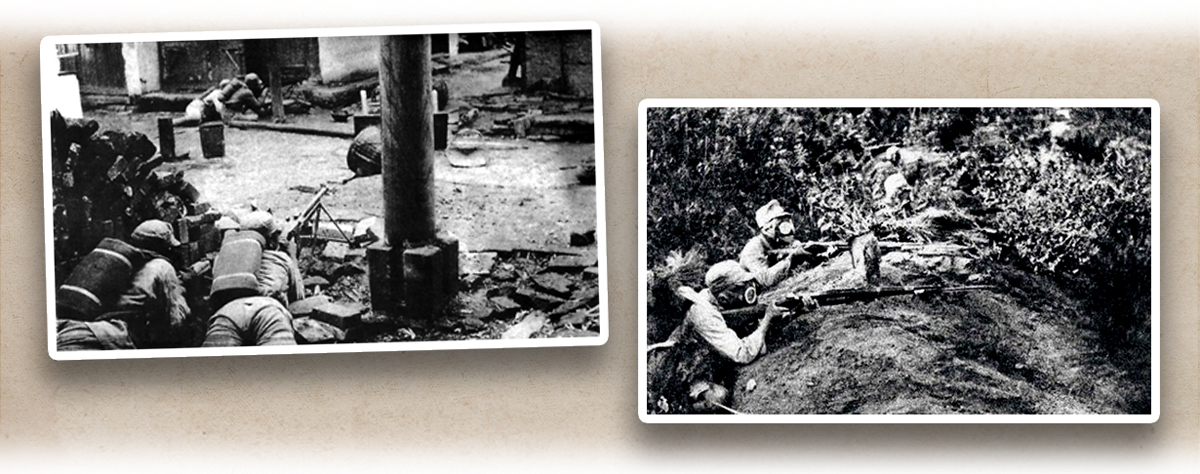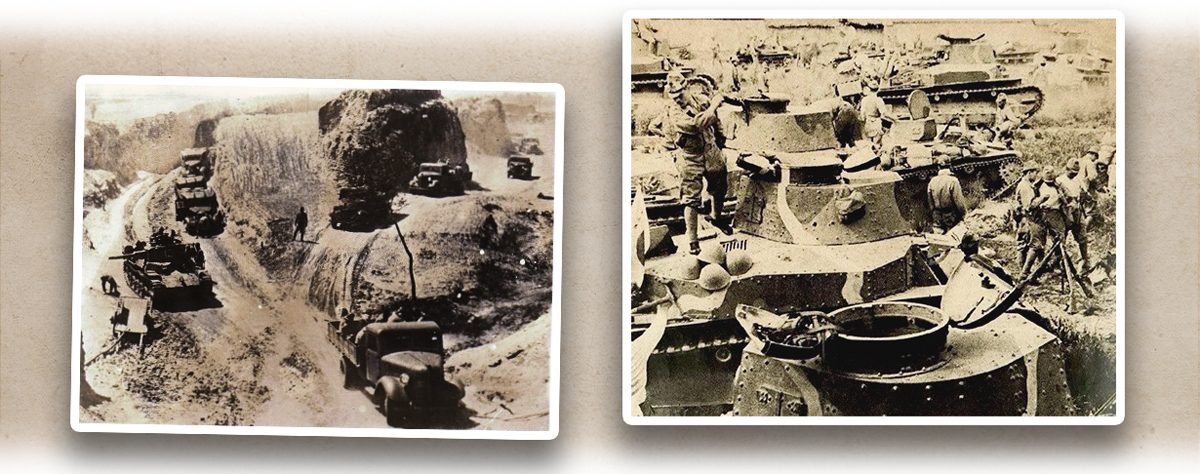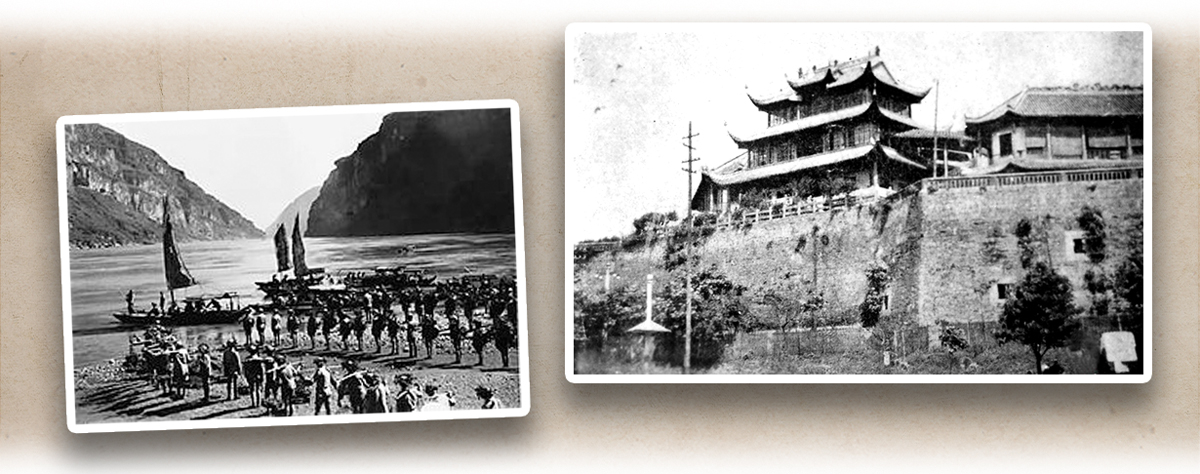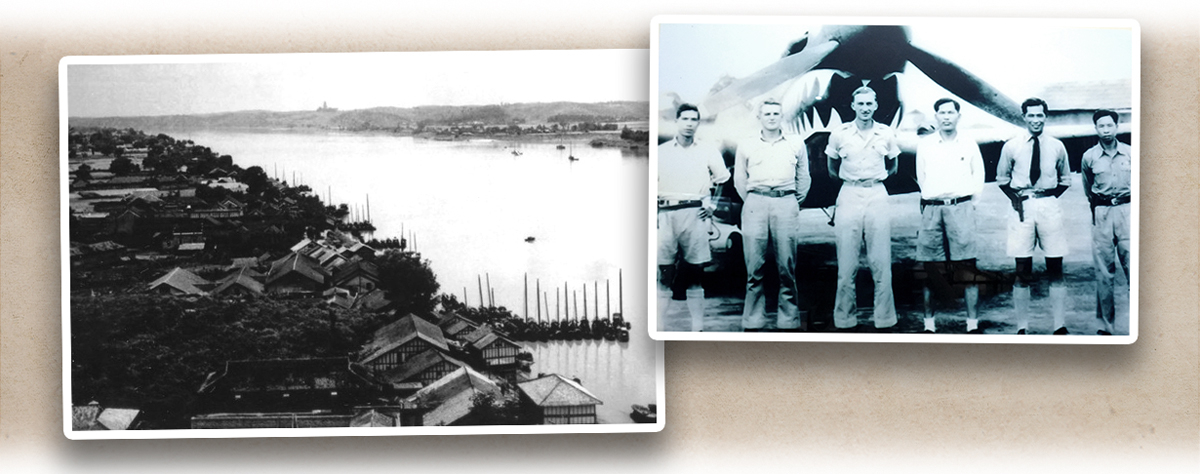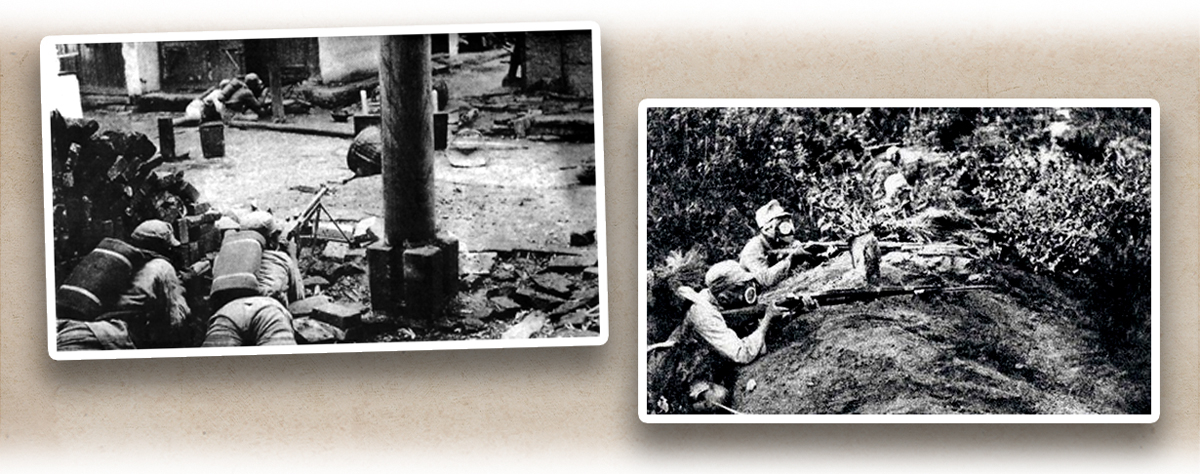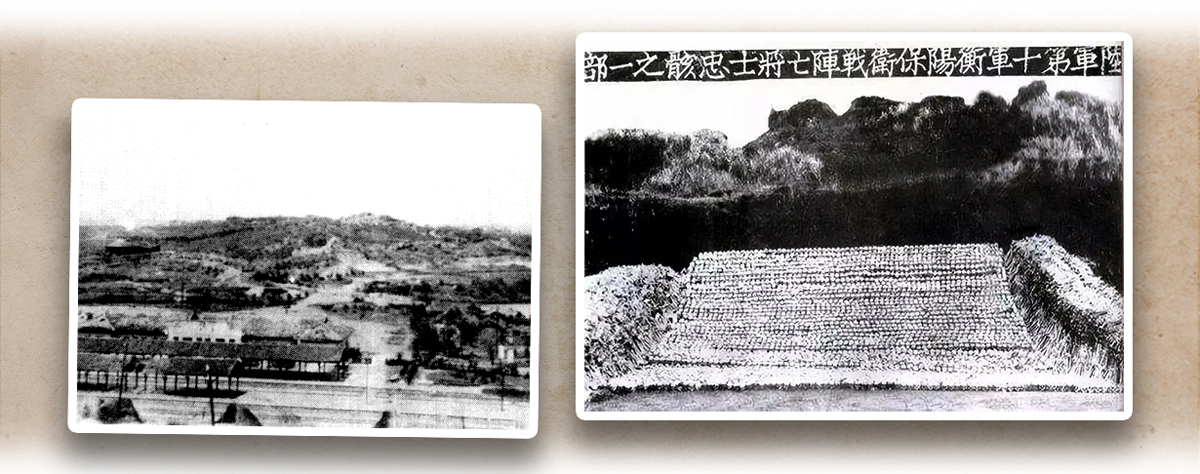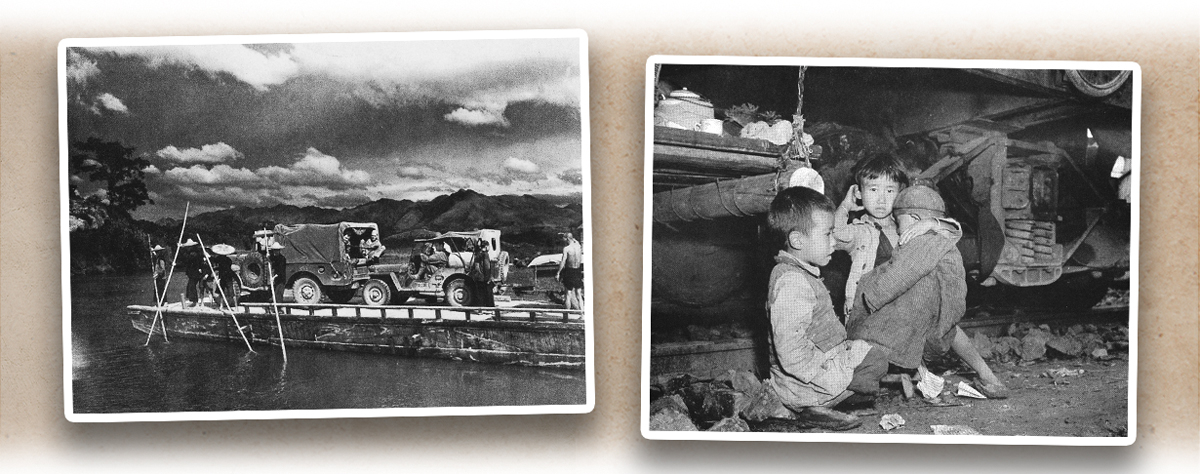After the outbreak of the Pacific War, Japan found itself fighting on multiple fronts. Starting in the middle of 1942, it was defeated in a series of battles with the United States. To uplift morale, build a route from north to southwest China and even Southeast Asia, and eliminate the United States’ airfields in China, Japan placed its bets on a victory in China. Hata Shunroku, the Commanding General of Japan’s Central China Expeditionary Army, launched the Operation Ichi-Go (Operation Number One) or Tairiku Datsū Sakusen (Continent Cross-Through Operation). The battle is known in China as the Battle of Henan-Hunan-Guangxi (豫湘桂會戰), which lasted from April to December 1944. The operation can be divided into three phases:
(1) Battle of Central Henan (豫中會戰): from mid-April to early June, Okamura Yasuji commanded the Japanese seizure of Zhengzhou (鄭州), Luoyang (洛陽), and the Beiping-Hankou Railway (平漢鐵路) The National Revolutionary Army’s (NRA) defence was led by commanders including Jiang Dingwen (蔣鼎文).
(2) Campaign of Changsha-Hengyang (長衡會戰): from early May to early August, the Japanese headed for Changsha (長沙) and Hengyang (衡陽) under the command of Yokoyama Isamu, where they encountered the NRA led by Xue Yue (薛岳). Japan’s assault on Changsha from 27 May to 18 June is also referred to as the Fourth Battle of Changsha.
(3) Battle of Guilin-Liuzhou (桂柳會戰): from early August to early December, Okamura Yasuji directed the attack on Guilin (桂林) and Liuzhou (柳州). Commanders including Zhang Fakui (張發奎) and Tang Enbo (湯恩伯) were responsible for the NRA’s defence.
Around 100,000 casualties were inflicted among the 410,000 Japanese troops in the Battle of Henan-Hunan-Guangxi. The 2,500,000 forces of NRA suffered around 600,000 casualties. In this battle, China lost large parts of provinces including Henan (河南), Hunan (湖南), Guangdong (廣東), Guangxi (廣西), and Fujian (福建), and some territories in Guizhou (貴州). Over 100 cities, including Xuchang (許昌), Luoyang, Changsha, Hengyang, Guilin, and Liuzhou, seven air bases, and 36 airfields were lost. This was the NRA’s second devastating defeat in the centre-stage battlefield since the full-scale War of Resistance . For the Japanese, although the operation succeeded, its strength was beyond salvation.
|
|
Why did Japan still launch a massive attack on China when the end of World War II was approaching in the mid-1944? |
|
|
See answer below. |
Japan launched the Operation Ichi-Go to attack provinces including Henan, Hunan, and Guangxi in China in mid-1944. The scale of the Japanese armoured troops mobilised in the operation was unprecedented since the aggression against China.
The Battle of Central Henan from mid-April to early June 1944 was the first phase of the Battle of Henan-Hunan-Guangxi. Left: the Japanese troops attacking Henan. Right: Japanese fleet of armoured vehicles advancing towards Luoyang, a major city in Henan.
The NRA fought hard but could not stop the advancing Japanese troops. Japan occupied Henan within a little over a month. From left to right: the Chinese soldiers fighting in the Battle of Central Henan; Division Commander Lu Gongliang (呂公良) and Commander-in-Chief Li Jiayu (李家鈺) of the Chinese defensive force in the Battle of Central Henan both died in combat.
Lu Gongliang, the Commander of the NRA New 29th Division of the 15th Corps, defended Xuchang with his troops to death when Japan attacked the city on 30 April 1944. Xuchang ultimately fell on 1 May. Lu Gongliang and the entire New 29th Division were all sacrificed.
In May 1944, Japan sieged Luoyang. Li Jiayu, the Commander-in-Chief of the 36th Army Group, was killed on 21 May and Luoyang fell on 25 May.
The Campaign of Changsha-Hengyang represented the second phase of the Battle of Henan-Hunan-Guangxi. The cities of Changsha and Hengyang in Hunan became key battlefields. Left: the NRA in the Fourth Battle of Changsha. Right: Tianxin Pavilion (天心閣), a gate tower on the city wall of Changsha. During the Fourth Battle of Changsha, the Japanese attacked areas in the vicinity of Tianxin Pavilion and seized Changsha on 18 June 1944.
Left: the pre-war Hengyang. Right: Flying Tigers personnel taking pictures at the Hengyang Airfield. Hengyang lied at the intersection of the Guangzhou-Hankou Railway (粵漢鐵路) and the Hunan-Guangxi Railway (湘桂鐵路). It was also a hub of roads and waterways in southwest China. With its booming industries and commerce, Hengyang was the third major city right behind Chongqing (重慶) and Kunming (昆明) in the Nationalist-controlled areas during the war. Its airfield was another strategic reason for Japanese seizure.
Japan’s assault on Hengyang started on 22 June 1944 and lasted over a month. It used gas shells causing great casualties for the NRA, who still put up a fierce struggle during the intense battle. The photo shows the NRA in combat.
The Defence of Hengyang (22 June-8 August 1944) marked one of the rare occasions during the War of Resistance when the NRA was outnumbered by the Japanese. Of all the battles recorded in Japanese history, this was the only one when Japan’s casualties exceeded those of China. The 17,000-strong 10th Corps of the NRA was blockaded in Hengyang by 110,000 Japanese troops. On a battlefield of merely two square kilometres, the NRA engaged the enemy in brutal hand-to-hand combat and the latter won yet at a huge cost. China reported the Japanese casualties between 48,000 and 60,000. Japan maintained that its casualties were around 20,000. Among the killed were Lieutenant-General Sakuma Tameto, the Commander of the 68th Division and the Major-General Shima Genkichi, the Commander of the 57th Brigade. The 10th Corps was annihilated and 7,000-odd were killed. More than 9,000 of the Corps were held captive, among which around 8,000 were wounded. Commander Fang Xianjue (方先覺) became a war prisoner but was later rescued.
Hengyang fell on 8 August 1944. Left: the NRA blowing up its facilities before the Japanese arrival. Right: the Japanese breaching the defence of Hengyang.
Left: the NRA’s base at Zhangjiashan (or Zhangjia Mountain, 張家山), Hengyang. Right: the fallen soldiers from the 10th Corps in Zhangjiashan in the Defence of Hengyang.
Zhangjiashan is a 60-metre tall hill in west Hengyang, a vantage point for the defensive force. Much blood was shed in dozens of engagements at Zhangjiashan, as the control of the hill alternated back and forth between the two sides during the Defence of Hengyang. The fight at Zhangjiashan was the deadliest during the Defence of Hengyang with 7,000-odd soldiers from both sides lost their lives altogether.
The Hengyang Anti-Japanese War Memorial City stands as a commemoration of the historic battle. Left: the monument in Hengyang Anti-Japanese War Memorial City. Right: the memorial stele in the City with the names of the commanding officers in the 10th Corps who defended Hengyang, including Commander Fang Xianjue and Chief-of-Staff Sun Mingyu (孫鳴玉).
Between early August and early December 1944, the Battle of Guilin-Liuzhou broke out. The Battle of Henan-Hunan-Guangxi entered its third phase as the main battlefield shifted to Guilin and Liuzhou. Left: Chinese transport fleets evacuating from Guilin, Guangxi, before the Battle of Guilin-Liuzhou (taken on 29 June 1944). Right: Liuzhou fell on 10 November and Guilin the next day. As the Battle of Guilin-Liuzhou ended in early December, so did the Battle of Henan-Hunan-Guangxi. The battle ended in Japanese victory but the Japanese forces were stretched to their limits. It was unable to pull off another operation of the same scale since then.
|
|
Why did Japan launch a massive attack on China when the end of World War II was approaching in mid-1944? |
|
|
During World War II, especially when halfway through the Sino-Japanese war, Japan’s ambition grew as it conquered vast territories in China. It thus attacked Pearl Harbour and invaded Southeast Asia. However, the Pacific War resulted in an American alliance with China, Britain, and other countries who attacked Japan on multiple fronts. China sent an expeditionary force to Myanmar while the United States Air Force bombed the Japanese navy and homeland by using Chinese airfields. As for naval warfare, Japan suffered a series of losses after its defeat in the Battle of Midway in June 1942. On 18 April 1943, the mastermind behind the Pearl Harbour attack, the Commander-in-Chief of the Combined Fleet Yamamoto Isoroku, was killed as his aircraft was shot down by the Americans. His death sent a heavy blow to the Japanese national morale. As a result, Japan decided to strengthen its foothold in China, making China its headquarters for global warfare and boosting the diminishing morale of its troops and civilians with victories in China. To this end, Japan deployed its largest number of forces since its invasion of China during the Battle of Henan-Hunan-Guangxi. Besides conquering China, the objectives of this campaign also included establishing routes connecting the northeast, north, central, and southwest China and even the Indo-China Peninsula to cut off China’s route of supplies, and destroying American airfields in China to hamper American air raids on the Japanese navy and mainland. Japan achieved some of its objectives but it could not debilitate the NRA, nor could it keep its transport routes in China stable. The United States Air Force continued to attack mainland Japan and the Japanese forces were thinned out and overextended with no hope for a comeback. After the Battle of Henan-Hunan-Guangxi, Japan was unable to launch a similar operation in China and the United States was closing in on mainland Japan. It was only a matter of time before Japan surrendered. |
Source of most photos used in this feature piece: Fotoe and misc. photo sources.




